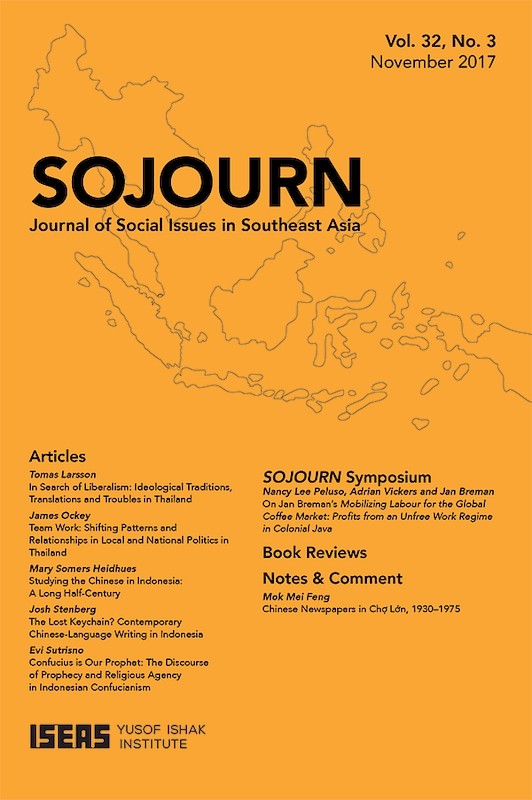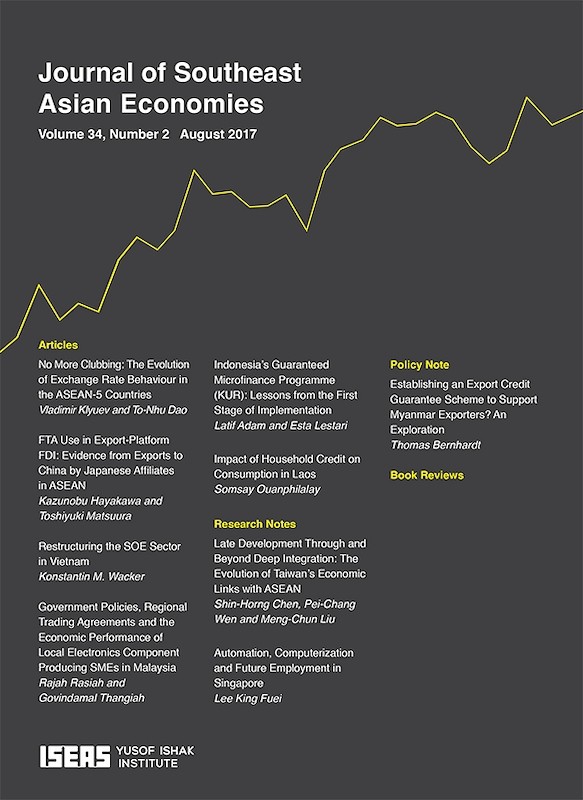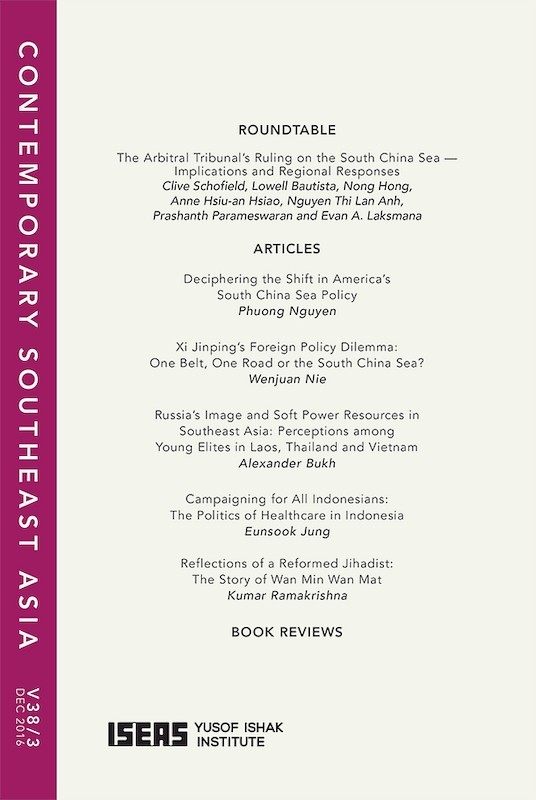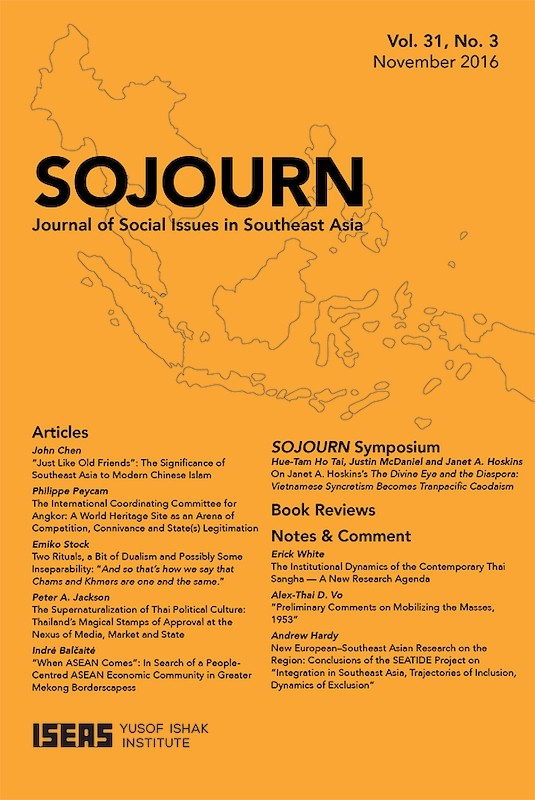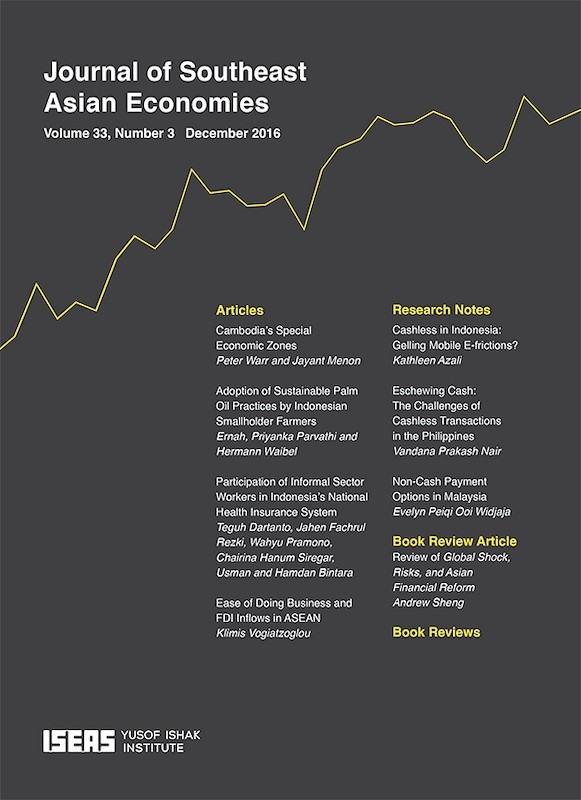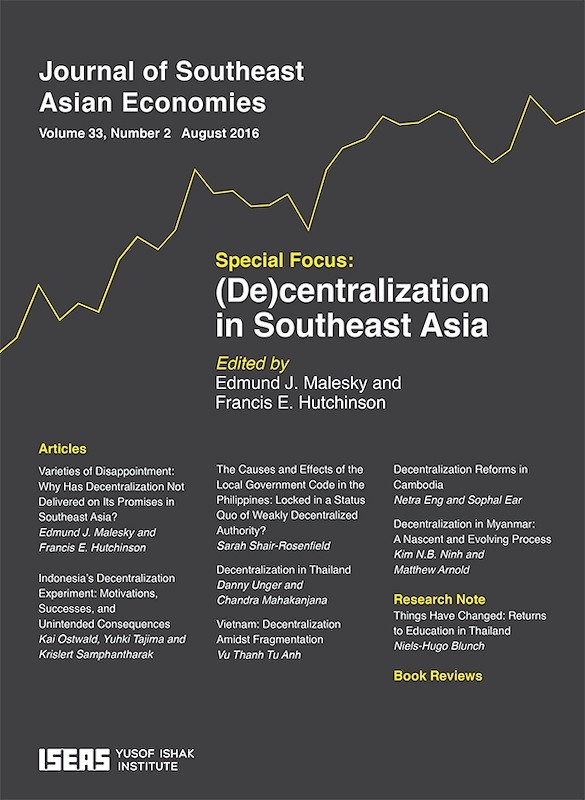Southeast Asian Affairs 2014
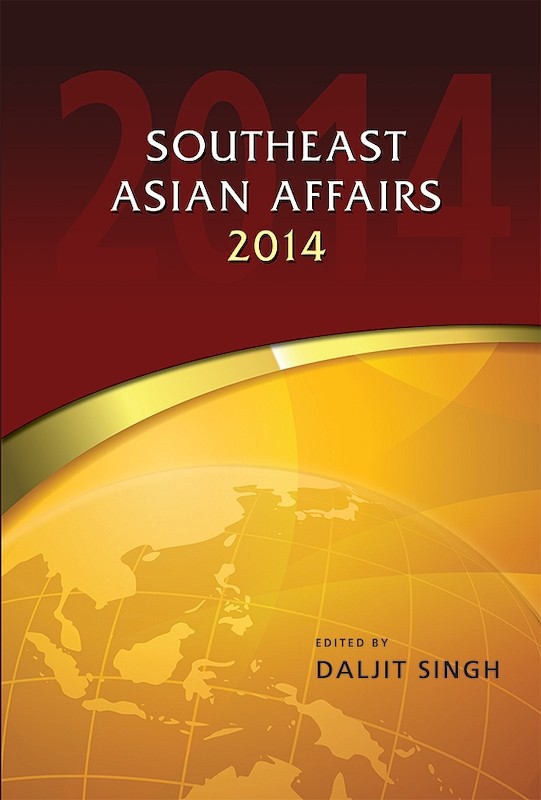
Daljit Singh, editor
Date of publication:
2014
Publisher:
Institute of Southeast Asian Studies
Number of pages:
372
Code:
SEAA14
Hard Cover
ISBN: 9789814517959
Soft Cover
ISBN: 9789814517942
About the publication
"Southeast Asian Affairs is the only one of its kind: a comprehensive annual review devoted to the international relations, politics, and economies of the region and its nation-states. The collected volumes of Southeast Asian Affairs have become a compendium documenting the dynamic evolution of regional and national developments in Southeast Asia from the end of the 'second' Vietnam War to the alarms and struggles of today. Over the years, the editors have drawn on the talents and expertise not only of ISEAS' own professional research staff and visiting fellows, but have also reached out to tap leading scholars and analysts elsewhere in Southeast and East Asia, Australia and New Zealand, North America, and Europe. A full list of contributors over forty years reads like a kind of whos' who in Southeast Asian Studies.
Regardless of specific events and outcomes in political, economic, and social developments in Southeast Asia's future, we can expect future editions of Southeast Asian Affairs to continue to provide the expert analysis that has marked the publication since its founding. It has become an important contributor to the knowledge base of contemporary Southeast Asia." - Donald E. Weatherbee, Russell Distinguished Professor Emeritus, University of South Carolina
The e-chapter on "Thailand in 2013: Haunted by the History of a Perilous Tomorrow" by Nicholas Farrelly is downloadable free of charge.
Regardless of specific events and outcomes in political, economic, and social developments in Southeast Asia's future, we can expect future editions of Southeast Asian Affairs to continue to provide the expert analysis that has marked the publication since its founding. It has become an important contributor to the knowledge base of contemporary Southeast Asia." - Donald E. Weatherbee, Russell Distinguished Professor Emeritus, University of South Carolina
The e-chapter on "Thailand in 2013: Haunted by the History of a Perilous Tomorrow" by Nicholas Farrelly is downloadable free of charge.
Contents
-
Southeast Asian Affairs 2014
[Whole Publication, ISBN: 9789814517966], by Daljit Singh, author -
Preliminary pages
- THE REGION
-
The Quest for Regional and Domestic Stability, by Joseph Chinyong Liow, Rajni Gamage, authors see abstract<style> <!-- /* Font Definitions */ @font-face {font-family:"Cordia New"; panose-1:0 0 0 0 0 0 0 0 0 0; mso-font-charset:222; mso-generic-font-family:roman; mso-font-format:other; mso-font-pitch:variable; mso-font-signature:16777217 0 0 0 65536 0;} @font-face {font-family:"Cordia New"; panose-1:0 0 0 0 0 0 0 0 0 0; mso-font-charset:222; mso-generic-font-family:roman; mso-font-format:other; mso-font-pitch:variable; mso-font-signature:16777217 0 0 0 65536 0;} @font-face {font-family:Calibri; panose-1:2 15 5 2 2 2 4 3 2 4; mso-font-charset:0; mso-generic-font-family:auto; mso-font-pitch:variable; mso-font-signature:-520092929 1073786111 9 0 415 0;} /* Style Definitions */ p.MsoNormal, li.MsoNormal, div.MsoNormal {mso-style-unhide:no; mso-style-qformat:yes; mso-style-parent:""; margin-top:0cm; margin-right:0cm; margin-bottom:8.0pt; margin-left:0cm; line-height:107%; mso-pagination:widow-orphan; font-size:11.0pt; font-family:Calibri; mso-ascii-font-family:Calibri; mso-ascii-theme-font:minor-latin; mso-fareast-font-family:Calibri; mso-fareast-theme-font:minor-latin; mso-hansi-font-family:Calibri; mso-hansi-theme-font:minor-latin; mso-bidi-font-family:"Cordia New"; mso-bidi-theme-font:minor-bidi; mso-ansi-language:EN-SG;} p.MsoPlainText, li.MsoPlainText, div.MsoPlainText {mso-style-noshow:yes; mso-style-priority:99; mso-style-link:"Plain Text Char"; margin:0cm; margin-bottom:.0001pt; mso-pagination:widow-orphan; font-size:11.0pt; mso-bidi-font-size:10.5pt; font-family:Calibri; mso-fareast-font-family:Calibri; mso-fareast-theme-font:minor-latin; mso-bidi-font-family:"Cordia New"; mso-bidi-theme-font:minor-bidi; mso-ansi-language:EN-SG;} span.PlainTextChar {mso-style-name:"Plain Text Char"; mso-style-noshow:yes; mso-style-priority:99; mso-style-unhide:no; mso-style-locked:yes; mso-style-link:"Plain Text"; mso-bidi-font-size:10.5pt; font-family:Calibri; mso-ascii-font-family:Calibri; mso-hansi-font-family:Calibri;} .MsoChpDefault {mso-style-type:export-only; mso-default-props:yes; font-size:11.0pt; mso-ansi-font-size:11.0pt; mso-bidi-font-size:11.0pt; font-family:Calibri; mso-ascii-font-family:Calibri; mso-ascii-theme-font:minor-latin; mso-fareast-font-family:Calibri; mso-fareast-theme-font:minor-latin; mso-hansi-font-family:Calibri; mso-hansi-theme-font:minor-latin; mso-bidi-font-family:"Cordia New"; mso-bidi-theme-font:minor-bidi; mso-ansi-language:EN-SG;} .MsoPapDefault {mso-style-type:export-only; margin-bottom:8.0pt; line-height:107%;} @page WordSection1 {size:612.0pt 792.0pt; margin:72.0pt 90.0pt 72.0pt 90.0pt; mso-header-margin:36.0pt; mso-footer-margin:36.0pt; mso-paper-source:0;} div.WordSection1 {page:WordSection1;} --></style>The year 2013 proved to be a challenging year for Southeast Asia. Within the region, ASEAN's priorities were to re-establish regional unity and cohesion after the difficulties under Cambodian chairmanship in 2012, and as the organization looks forward to the ASEAN Economic Community in 2015. Meanwhile, relations with external powers proved equally demanding especially in the wake of increased Chinese assertiveness in the South China Sea and potential stumbling blocks to the "pivot" strategy of the Obama administration. For some Southeast Asian states however, it was arguably domestic politics that proved most trying over the past year as ruling regimes in key regional states were confronted with challenges to their legitimacy, which would likely continue to define their domestic politics and distract them from foreign policy in the coming years.
-
Southeast Asian Economies: Waiting for a Rebound, by Sanchita Basu Das, author see abstract<style> <!-- /* Font Definitions */ @font-face {font-family:"Cordia New"; panose-1:0 0 0 0 0 0 0 0 0 0; mso-font-charset:222; mso-generic-font-family:roman; mso-font-format:other; mso-font-pitch:variable; mso-font-signature:16777217 0 0 0 65536 0;} @font-face {font-family:"Cambria Math"; panose-1:2 4 5 3 5 4 6 3 2 4; mso-font-charset:0; mso-generic-font-family:auto; mso-font-pitch:variable; mso-font-signature:3 0 0 0 1 0;} @font-face {font-family:Calibri; panose-1:2 15 5 2 2 2 4 3 2 4; mso-font-charset:0; mso-generic-font-family:auto; mso-font-pitch:variable; mso-font-signature:-520092929 1073786111 9 0 415 0;} /* Style Definitions */ p.MsoNormal, li.MsoNormal, div.MsoNormal {mso-style-unhide:no; mso-style-qformat:yes; mso-style-parent:""; margin-top:0cm; margin-right:0cm; margin-bottom:8.0pt; margin-left:0cm; line-height:107%; mso-pagination:widow-orphan; font-size:11.0pt; font-family:Calibri; mso-ascii-font-family:Calibri; mso-ascii-theme-font:minor-latin; mso-fareast-font-family:Calibri; mso-fareast-theme-font:minor-latin; mso-hansi-font-family:Calibri; mso-hansi-theme-font:minor-latin; mso-bidi-font-family:"Cordia New"; mso-bidi-theme-font:minor-bidi; mso-ansi-language:EN-SG;} .MsoChpDefault {mso-style-type:export-only; mso-default-props:yes; font-size:11.0pt; mso-ansi-font-size:11.0pt; mso-bidi-font-size:11.0pt; font-family:Calibri; mso-ascii-font-family:Calibri; mso-ascii-theme-font:minor-latin; mso-fareast-font-family:Calibri; mso-fareast-theme-font:minor-latin; mso-hansi-font-family:Calibri; mso-hansi-theme-font:minor-latin; mso-bidi-font-family:"Cordia New"; mso-bidi-theme-font:minor-bidi; mso-ansi-language:EN-SG;} .MsoPapDefault {mso-style-type:export-only; margin-bottom:8.0pt; line-height:107%;} @page WordSection1 {size:612.0pt 792.0pt; margin:72.0pt 90.0pt 72.0pt 90.0pt; mso-header-margin:36.0pt; mso-footer-margin:36.0pt; mso-paper-source:0;} div.WordSection1 {page:WordSection1;} --></style>In 2013, growth momentum in Southeast Asia moderated to 5.2 per cent compared to 5.4 per cent the year before. Sluggish performance was observed in three big economies – Indonesia, Malaysia, and Thailand. Domestic demand played a key role, contributing to the aggregate output, while investment played down. Lacklustre exports continued to hold back growth in the region. During the year, the advanced economies of the US and the EU showed signs of improvement. But it was the slowdown in China and India that affected the sentiments of most of the Southeast Asian economies. This got further complicated by the talk of tapering quantitative easing by the US Fed that rocked the financial markets. Inflation remained subdued in 2013, owing mainly to lower commodity prices and slower economic growth globally. Southeast Asia is expected to show moderate recovery of 5.9 per cent in 2014. This is due to both external (slower Chinese economic growth, tighter liquidity in global markets, but improving conditions in the US, euro area and Japan) and domestic factors (like higher domestic interest rates and fiscal consolidation for some of these economies). In the medium-term, to deliver on a sustainable economic growth, policy-makers in the region must work on financial stability and pursue bold domestic reforms to increase productivity.
-
Southeast Asia and the Major Powers: Engagement not Entanglement , by Malcolm Cook, author see abstractSoutheast Asian states and ASEAN are benefitting from a historic period of great power engagement in the region. The United States, Japan, India and China each are enhancing their relations in the region bilaterally, through ASEAN and through larger regional groupings including Southeast Asian states. Much of the commentary of this historic moment has fretted over the risks of Southeast Asia’s small and medium-sized powers and ASEAN becoming entangled in major power competition. This chapter focuses on the benefits for Southeast Asian states of this enhanced great power engagement, the limited risk of this feared entanglement and how this simultaneous great power engagement precludes Chinese or American regional dominance. More can be merrier for Southeast Asian states if they appreciate and take advantage of the opportunities this enhanced engagement offer them individually and collectively. <style><!-- /* Font Definitions */ @font-face {font-family:"Cordia New"; panose-1:0 0 0 0 0 0 0 0 0 0; mso-font-charset:222; mso-generic-font-family:roman; mso-font-format:other; mso-font-pitch:variable; mso-font-signature:16777217 0 0 0 65536 0;} @font-face {font-family:"Cambria Math"; panose-1:2 4 5 3 5 4 6 3 2 4; mso-font-charset:0; mso-generic-font-family:auto; mso-font-pitch:variable; mso-font-signature:3 0 0 0 1 0;} @font-face {font-family:Calibri; panose-1:2 15 5 2 2 2 4 3 2 4; mso-font-charset:0; mso-generic-font-family:auto; mso-font-pitch:variable; mso-font-signature:-520092929 1073786111 9 0 415 0;} /* Style Definitions */ p.MsoNormal, li.MsoNormal, div.MsoNormal {mso-style-unhide:no; mso-style-qformat:yes; mso-style-parent:""; margin-top:0cm; margin-right:0cm; margin-bottom:8.0pt; margin-left:0cm; line-height:107%; mso-pagination:widow-orphan; font-size:11.0pt; font-family:Calibri; mso-ascii-font-family:Calibri; mso-ascii-theme-font:minor-latin; mso-fareast-font-family:Calibri; mso-fareast-theme-font:minor-latin; mso-hansi-font-family:Calibri; mso-hansi-theme-font:minor-latin; mso-bidi-font-family:"Cordia New"; mso-bidi-theme-font:minor-bidi; mso-ansi-language:EN-SG;} .MsoChpDefault {mso-style-type:export-only; mso-default-props:yes; font-size:11.0pt; mso-ansi-font-size:11.0pt; mso-bidi-font-size:11.0pt; font-family:Calibri; mso-ascii-font-family:Calibri; mso-ascii-theme-font:minor-latin; mso-fareast-font-family:Calibri; mso-fareast-theme-font:minor-latin; mso-hansi-font-family:Calibri; mso-hansi-theme-font:minor-latin; mso-bidi-font-family:"Cordia New"; mso-bidi-theme-font:minor-bidi; mso-ansi-language:EN-SG;} .MsoPapDefault {mso-style-type:export-only; margin-bottom:8.0pt; line-height:107%;} @page WordSection1 {size:612.0pt 792.0pt; margin:72.0pt 90.0pt 72.0pt 90.0pt; mso-header-margin:36.0pt; mso-footer-margin:36.0pt; mso-paper-source:0;} div.WordSection1 {page:WordSection1;} --> </style>
-
ASEAN: Managing External Political and Security Relations, by Termsak Chalermpalanupap, author see abstract<style> <!-- /* Font Definitions */ @font-face {font-family:"Cordia New"; panose-1:0 0 0 0 0 0 0 0 0 0; mso-font-charset:222; mso-generic-font-family:roman; mso-font-format:other; mso-font-pitch:variable; mso-font-signature:16777217 0 0 0 65536 0;} @font-face {font-family:"Cambria Math"; panose-1:2 4 5 3 5 4 6 3 2 4; mso-font-charset:0; mso-generic-font-family:auto; mso-font-pitch:variable; mso-font-signature:3 0 0 0 1 0;} @font-face {font-family:Calibri; panose-1:2 15 5 2 2 2 4 3 2 4; mso-font-charset:0; mso-generic-font-family:auto; mso-font-pitch:variable; mso-font-signature:-520092929 1073786111 9 0 415 0;} /* Style Definitions */ p.MsoNormal, li.MsoNormal, div.MsoNormal {mso-style-unhide:no; mso-style-qformat:yes; mso-style-parent:""; margin-top:0cm; margin-right:0cm; margin-bottom:8.0pt; margin-left:0cm; line-height:107%; mso-pagination:widow-orphan; font-size:11.0pt; font-family:Calibri; mso-ascii-font-family:Calibri; mso-ascii-theme-font:minor-latin; mso-fareast-font-family:Calibri; mso-fareast-theme-font:minor-latin; mso-hansi-font-family:Calibri; mso-hansi-theme-font:minor-latin; mso-bidi-font-family:"Cordia New"; mso-bidi-theme-font:minor-bidi; mso-ansi-language:EN-SG;} .MsoChpDefault {mso-style-type:export-only; mso-default-props:yes; font-size:11.0pt; mso-ansi-font-size:11.0pt; mso-bidi-font-size:11.0pt; font-family:Calibri; mso-ascii-font-family:Calibri; mso-ascii-theme-font:minor-latin; mso-fareast-font-family:Calibri; mso-fareast-theme-font:minor-latin; mso-hansi-font-family:Calibri; mso-hansi-theme-font:minor-latin; mso-bidi-font-family:"Cordia New"; mso-bidi-theme-font:minor-bidi; mso-ansi-language:EN-SG;} .MsoPapDefault {mso-style-type:export-only; margin-bottom:8.0pt; line-height:107%;} @page WordSection1 {size:612.0pt 792.0pt; margin:72.0pt 90.0pt 72.0pt 90.0pt; mso-header-margin:36.0pt; mso-footer-margin:36.0pt; mso-paper-source:0;} div.WordSection1 {page:WordSection1;} --></style>This is a review of the strategic challenges in Southeast Asia in 2013 and how they affected ASEAN and its Member States. It seeks to answer one crucial question: How did ASEAN and its Member States cope? The answer is in enhancing the ASEAN centrality. When they operate as a group in ASEAN, ASEAN Member States would continue to keep ASEAN neutral, constructive, proactive and innovative in promoting dialogue and cooperation with all external friends and partners. At the same time, and more importantly, ASEAN Member States have been trying to build a peaceful, prosperous and caring ASEAN Community. Success in community-building will make ASEAN more credible and its centrality viable.
-
US-China Relations: Managing Differences Remains an Urgent Challenge, by Bonnie Glaser, author
- BRUNEI DARUSSALAM
-
Brunei in 2013: Paradoxes in Image and Performance?, by Christopher B Roberts, author see abstract<style> <!-- /* Font Definitions */ @font-face {font-family:"Cordia New"; panose-1:0 0 0 0 0 0 0 0 0 0; mso-font-charset:222; mso-generic-font-family:roman; mso-font-format:other; mso-font-pitch:variable; mso-font-signature:16777217 0 0 0 65536 0;} @font-face {font-family:"Cambria Math"; panose-1:2 4 5 3 5 4 6 3 2 4; mso-font-charset:0; mso-generic-font-family:auto; mso-font-pitch:variable; mso-font-signature:3 0 0 0 1 0;} @font-face {font-family:Calibri; panose-1:2 15 5 2 2 2 4 3 2 4; mso-font-charset:0; mso-generic-font-family:auto; mso-font-pitch:variable; mso-font-signature:-520092929 1073786111 9 0 415 0;} /* Style Definitions */ p.MsoNormal, li.MsoNormal, div.MsoNormal {mso-style-unhide:no; mso-style-qformat:yes; mso-style-parent:""; margin-top:0cm; margin-right:0cm; margin-bottom:8.0pt; margin-left:0cm; line-height:107%; mso-pagination:widow-orphan; font-size:11.0pt; font-family:Calibri; mso-ascii-font-family:Calibri; mso-ascii-theme-font:minor-latin; mso-fareast-font-family:Calibri; mso-fareast-theme-font:minor-latin; mso-hansi-font-family:Calibri; mso-hansi-theme-font:minor-latin; mso-bidi-font-family:"Cordia New"; mso-bidi-theme-font:minor-bidi; mso-ansi-language:EN-SG;} .MsoChpDefault {mso-style-type:export-only; mso-default-props:yes; font-size:11.0pt; mso-ansi-font-size:11.0pt; mso-bidi-font-size:11.0pt; font-family:Calibri; mso-ascii-font-family:Calibri; mso-ascii-theme-font:minor-latin; mso-fareast-font-family:Calibri; mso-fareast-theme-font:minor-latin; mso-hansi-font-family:Calibri; mso-hansi-theme-font:minor-latin; mso-bidi-font-family:"Cordia New"; mso-bidi-theme-font:minor-bidi; mso-ansi-language:EN-SG;} .MsoPapDefault {mso-style-type:export-only; margin-bottom:8.0pt; line-height:107%;} @page WordSection1 {size:612.0pt 792.0pt; margin:72.0pt 90.0pt 72.0pt 90.0pt; mso-header-margin:36.0pt; mso-footer-margin:36.0pt; mso-paper-source:0;} div.WordSection1 {page:WordSection1;} --></style>This chapter analyses the key developments in economic, political, and foreign affairs during the course of 2013. Brunei remains a political and economically stable country that provides some of the highest living standards, social welfare, and medical benefits in Asia. However, the chapter analyses a number of economic and political issues with the potential for more serious ramifications in the future. These include low economic growth that has been reinforced by a failure to significantly diversify the economy away from a dependence on hydrocarbon revenue and the continued consolidation of a more politically and religiously conservative environment. The latter was most significantly evidenced by the finalization of a sharia criminal code in 2013 that will commence from April 2014. However, in terms of the country’s foreign affairs, Brunei’s year as the Chair of ASEAN was largely very successful and the country continued to consolidate several key bilateral partnerships. <p class="MsoNormal" style="margin-bottom:0cm;margin-bottom:.0001pt;text-align: justify;line-height:normal"><span style="font-size:12.0pt; font-family:"Times New Roman";color:#1F497D;mso-ansi-language:EN-AU" lang="EN-AU"> </span></p>
- CAMBODIA
-
Cambodia in 2013: The Winds of Change, by Khatharya Um, author see abstractFor a Cambodia that has revealed few surprises over the last two decades, 2013 proved to be a year of unprecedented volatility. The political landscape of 2013 was fraught with tension in Thai-Cambodia relations over the contested Preah Vihear temple and post-election upheavals that locked the country in a yet-to-be resolved political impasse and threatened to derail the country’s heretofore impressive economic growth. Along with persisting conflicts and violence over land grabs, labour exploitation and environmental degradation, corruption, weak system of accountability and transparency, and general elusiveness of the rule of law continue to undermine democratization. Meanwhile, the Khmer Rouge Tribunal creaked along amidst deaths of surviving Khmer Rouge leaders, scandals, charges of political interference, and chronic funding deficit. King Norodom Sihanouk’s cremation in February 2013 marked the end of an era, evoking an ever-looming question about the role and future of the monarchy in Cambodia.
- INDONESIA
-
Indonesia in 2013: Anticipating 2014, by Ulla Fionna, Siwage Dharma Negara, Hui Yew-Foong, authors see abstract<style> <!-- /* Font Definitions */ @font-face {font-family:"Cordia New"; panose-1:0 0 0 0 0 0 0 0 0 0; mso-font-charset:222; mso-generic-font-family:roman; mso-font-format:other; mso-font-pitch:variable; mso-font-signature:16777217 0 0 0 65536 0;} @font-face {font-family:"Cambria Math"; panose-1:2 4 5 3 5 4 6 3 2 4; mso-font-charset:0; mso-generic-font-family:auto; mso-font-pitch:variable; mso-font-signature:3 0 0 0 1 0;} @font-face {font-family:Calibri; panose-1:2 15 5 2 2 2 4 3 2 4; mso-font-charset:0; mso-generic-font-family:auto; mso-font-pitch:variable; mso-font-signature:-520092929 1073786111 9 0 415 0;} /* Style Definitions */ p.MsoNormal, li.MsoNormal, div.MsoNormal {mso-style-unhide:no; mso-style-qformat:yes; mso-style-parent:""; margin-top:0cm; margin-right:0cm; margin-bottom:8.0pt; margin-left:0cm; line-height:107%; mso-pagination:widow-orphan; font-size:11.0pt; font-family:Calibri; mso-ascii-font-family:Calibri; mso-ascii-theme-font:minor-latin; mso-fareast-font-family:Calibri; mso-fareast-theme-font:minor-latin; mso-hansi-font-family:Calibri; mso-hansi-theme-font:minor-latin; mso-bidi-font-family:"Cordia New"; mso-bidi-theme-font:minor-bidi; mso-ansi-language:EN-SG;} .MsoChpDefault {mso-style-type:export-only; mso-default-props:yes; font-size:11.0pt; mso-ansi-font-size:11.0pt; mso-bidi-font-size:11.0pt; font-family:Calibri; mso-ascii-font-family:Calibri; mso-ascii-theme-font:minor-latin; mso-fareast-font-family:Calibri; mso-fareast-theme-font:minor-latin; mso-hansi-font-family:Calibri; mso-hansi-theme-font:minor-latin; mso-bidi-font-family:"Cordia New"; mso-bidi-theme-font:minor-bidi; mso-ansi-language:EN-SG;} .MsoPapDefault {mso-style-type:export-only; margin-bottom:8.0pt; line-height:107%;} @page WordSection1 {size:612.0pt 792.0pt; margin:72.0pt 90.0pt 72.0pt 90.0pt; mso-header-margin:36.0pt; mso-footer-margin:36.0pt; mso-paper-source:0;} div.WordSection1 {page:WordSection1;} --></style>As a nation that is gearing up for arguably its most important elections yet in 2014, Indonesia has to grapple with the fact that there are urgent challenges to address. The fight against corruption for one, reveals the extent of this problem in Indonesia. The various cases demonstrate that state institutions and public officials are still particularly prone to corruption. Meanwhile, sectarianism and local/communal conflicts may be on the decline, but they continue to highlight the sensitiveness of these issues at the grassroots. As the Indonesian economy also continues to face serious challenges in maintaining growth, the current president Susilo Bambang Yudhoyono’s strongest legacy will likely be in upkeeping Indonesia’s international standing.
-
Terrorism in Indonesia: A Fading Threat?, by Sidney Jones, Solahudin, authors see abstract<style> <!-- /* Font Definitions */ @font-face {font-family:"Cordia New"; panose-1:0 0 0 0 0 0 0 0 0 0; mso-font-charset:222; mso-generic-font-family:roman; mso-font-format:other; mso-font-pitch:variable; mso-font-signature:16777217 0 0 0 65536 0;} @font-face {font-family:"Cambria Math"; panose-1:2 4 5 3 5 4 6 3 2 4; mso-font-charset:0; mso-generic-font-family:auto; mso-font-pitch:variable; mso-font-signature:3 0 0 0 1 0;} @font-face {font-family:Calibri; panose-1:2 15 5 2 2 2 4 3 2 4; mso-font-charset:0; mso-generic-font-family:auto; mso-font-pitch:variable; mso-font-signature:-520092929 1073786111 9 0 415 0;} /* Style Definitions */ p.MsoNormal, li.MsoNormal, div.MsoNormal {mso-style-unhide:no; mso-style-qformat:yes; mso-style-parent:""; margin-top:0cm; margin-right:0cm; margin-bottom:8.0pt; margin-left:0cm; line-height:107%; mso-pagination:widow-orphan; font-size:11.0pt; font-family:Calibri; mso-ascii-font-family:Calibri; mso-ascii-theme-font:minor-latin; mso-fareast-font-family:Calibri; mso-fareast-theme-font:minor-latin; mso-hansi-font-family:Calibri; mso-hansi-theme-font:minor-latin; mso-bidi-font-family:"Cordia New"; mso-bidi-theme-font:minor-bidi; mso-ansi-language:EN-SG;} .MsoChpDefault {mso-style-type:export-only; mso-default-props:yes; font-size:11.0pt; mso-ansi-font-size:11.0pt; mso-bidi-font-size:11.0pt; font-family:Calibri; mso-ascii-font-family:Calibri; mso-ascii-theme-font:minor-latin; mso-fareast-font-family:Calibri; mso-fareast-theme-font:minor-latin; mso-hansi-font-family:Calibri; mso-hansi-theme-font:minor-latin; mso-bidi-font-family:"Cordia New"; mso-bidi-theme-font:minor-bidi; mso-ansi-language:EN-SG;} .MsoPapDefault {mso-style-type:export-only; margin-bottom:8.0pt; line-height:107%;} @page WordSection1 {size:612.0pt 792.0pt; margin:72.0pt 90.0pt 72.0pt 90.0pt; mso-header-margin:36.0pt; mso-footer-margin:36.0pt; mso-paper-source:0;} div.WordSection1 {page:WordSection1;} --></style>Terrorism in Indonesia in 2013 continued to be low-tech and very low-casualty, but there was no shortage of recruits. Most of the terrorist activity during the year was attributable to two networks, the Mujahidin of Eastern Indonesia (Mujahidin Indonesia Timur, MIT), based in Poso, Central Sulawesi, and the Mujahidin of Western Indonesia (Mujahidin Indonesia Barat, MIB), based in greater Jakarta and West Java. The two were not formally linked. Several other small groups emerged independently, with poorly trained members who looked more like petty criminals than mass killers. Would-be terrorists killed a total of three during the year, all police, while police shot dead twenty-one suspects. If serious terrorism seemed to be in remission, three factors could lead to a resurgence: anger over police tactics; releases of some convicted terrorists as they completed their prison terms; and the conflict in Syria, which was attracting dozens of Indonesian mujahidin.
- LAOS
-
Laos in 2013: International Controversies, Economic Concerns and the Post-Socialist Rhetoric of Rule, by Simon Creak, author see abstract<style> <!-- /* Font Definitions */ @font-face {font-family:"Cordia New"; panose-1:0 0 0 0 0 0 0 0 0 0; mso-font-charset:222; mso-generic-font-family:roman; mso-font-format:other; mso-font-pitch:variable; mso-font-signature:16777217 0 0 0 65536 0;} @font-face {font-family:"Cambria Math"; panose-1:2 4 5 3 5 4 6 3 2 4; mso-font-charset:0; mso-generic-font-family:auto; mso-font-pitch:variable; mso-font-signature:3 0 0 0 1 0;} @font-face {font-family:Calibri; panose-1:2 15 5 2 2 2 4 3 2 4; mso-font-charset:0; mso-generic-font-family:auto; mso-font-pitch:variable; mso-font-signature:-520092929 1073786111 9 0 415 0;} /* Style Definitions */ p.MsoNormal, li.MsoNormal, div.MsoNormal {mso-style-unhide:no; mso-style-qformat:yes; mso-style-parent:""; margin-top:0cm; margin-right:0cm; margin-bottom:8.0pt; margin-left:0cm; line-height:107%; mso-pagination:widow-orphan; font-size:11.0pt; font-family:Calibri; mso-ascii-font-family:Calibri; mso-ascii-theme-font:minor-latin; mso-fareast-font-family:Calibri; mso-fareast-theme-font:minor-latin; mso-hansi-font-family:Calibri; mso-hansi-theme-font:minor-latin; mso-bidi-font-family:"Cordia New"; mso-bidi-theme-font:minor-bidi; mso-ansi-language:EN-SG;} .MsoChpDefault {mso-style-type:export-only; mso-default-props:yes; font-size:11.0pt; mso-ansi-font-size:11.0pt; mso-bidi-font-size:11.0pt; font-family:Calibri; mso-ascii-font-family:Calibri; mso-ascii-theme-font:minor-latin; mso-fareast-font-family:Calibri; mso-fareast-theme-font:minor-latin; mso-hansi-font-family:Calibri; mso-hansi-theme-font:minor-latin; mso-bidi-font-family:"Cordia New"; mso-bidi-theme-font:minor-bidi; mso-ansi-language:EN-SG;} .MsoPapDefault {mso-style-type:export-only; margin-bottom:8.0pt; line-height:107%;} @page WordSection1 {size:612.0pt 792.0pt; margin:72.0pt 90.0pt 72.0pt 90.0pt; mso-header-margin:36.0pt; mso-footer-margin:36.0pt; mso-paper-source:0;} div.WordSection1 {page:WordSection1;} --></style>In 2013, under the glare of uncharacteristic scrutiny, the ruling Lao People’s Revolutionary Party (LPRP) regime was unable or unwilling to explain how a prominent community leader could disappear in the company of police and maintained that a planned hydroelectric project damming part of the Mekong River was not a “mainstream” dam (i.e. on the main stem of the river). In some ways, these responses recalled an earlier period of LPRP rule when the regime routinely denied, obfuscated and stonewalled in the face of external criticism. But as the more sophisticated response by party leaders’ to an IMF-prescribed “overheating economy” indicated, the ways in which the LPRP utilizes language, rhetoric and other forms of communication have changed dramatically in the past two decades. In surveying four themes of the past year in Laos – the aftermath of Sombath Somphone’s enforced disappearance, the planned Don Sahong hydroelectric dam, the government’s budgetary problems and its Sam Sang or “Three Builds” campaign to reform centre-local relations – this article considers how the post-socialist rhetoric of rule buttresses state power in contemporary Laos.
- MALAYSIA
-
Malaysia in 2013: Najib's Pyrrhic Victory and the Demise of 1Malaysia, by James Chin, author see abstract<style> <!-- /* Font Definitions */ @font-face {font-family:"Cordia New"; panose-1:0 0 0 0 0 0 0 0 0 0; mso-font-charset:222; mso-generic-font-family:roman; mso-font-format:other; mso-font-pitch:variable; mso-font-signature:16777217 0 0 0 65536 0;} @font-face {font-family:"Cambria Math"; panose-1:2 4 5 3 5 4 6 3 2 4; mso-font-charset:0; mso-generic-font-family:auto; mso-font-pitch:variable; mso-font-signature:3 0 0 0 1 0;} @font-face {font-family:Calibri; panose-1:2 15 5 2 2 2 4 3 2 4; mso-font-charset:0; mso-generic-font-family:auto; mso-font-pitch:variable; mso-font-signature:-520092929 1073786111 9 0 415 0;} /* Style Definitions */ p.MsoNormal, li.MsoNormal, div.MsoNormal {mso-style-unhide:no; mso-style-qformat:yes; mso-style-parent:""; margin-top:0cm; margin-right:0cm; margin-bottom:8.0pt; margin-left:0cm; line-height:107%; mso-pagination:widow-orphan; font-size:11.0pt; font-family:Calibri; mso-ascii-font-family:Calibri; mso-ascii-theme-font:minor-latin; mso-fareast-font-family:Calibri; mso-fareast-theme-font:minor-latin; mso-hansi-font-family:Calibri; mso-hansi-theme-font:minor-latin; mso-bidi-font-family:"Cordia New"; mso-bidi-theme-font:minor-bidi; mso-ansi-language:EN-SG;} .MsoChpDefault {mso-style-type:export-only; mso-default-props:yes; font-size:11.0pt; mso-ansi-font-size:11.0pt; mso-bidi-font-size:11.0pt; font-family:Calibri; mso-ascii-font-family:Calibri; mso-ascii-theme-font:minor-latin; mso-fareast-font-family:Calibri; mso-fareast-theme-font:minor-latin; mso-hansi-font-family:Calibri; mso-hansi-theme-font:minor-latin; mso-bidi-font-family:"Cordia New"; mso-bidi-theme-font:minor-bidi; mso-ansi-language:EN-SG;} .MsoPapDefault {mso-style-type:export-only; margin-bottom:8.0pt; line-height:107%;} @page WordSection1 {size:612.0pt 792.0pt; margin:72.0pt 90.0pt 72.0pt 90.0pt; mso-header-margin:36.0pt; mso-footer-margin:36.0pt; mso-paper-source:0;} div.WordSection1 {page:WordSection1;} --></style>The Barisan National (BN) and the Opposition Pakatan Raykat (PR) fought at the long-awaited general elections (GE) in 2013. BN won the GE with a slim majority of twenty-two seats but lost the popular vote to PR. The results and the consequences of the GE was felt for the whole year. It was as if the entire country was consumed by the electoral results. When historians look back in 2013, they will see a country deeply divided by racial and religious politics, with the Najib government seemingly unwilling to confront the right-wing groups promoting religious bigotry and a racist agenda. The GE triggered a barricade mentality in UMNO and the right-wing groups who seemed determined to spread the ideology of hate using fear as their weapon. While UMNO moved to the right, the political middle ground was taken up by PAS and its partners in the PR. In summary, 2013 was the year in which the much heralded 1Malaysia, expounded by Najib when he came into power in 2009, was destroyed in plain sight.
-
Malaysia's Dilemma: Economic Reforms but Politics Stay the Same, by Abdillah Noh, author see abstractThe outcome of Malaysia’s 13th general election gave markets a huge relief. Markets were looking for more economic reforms and continuity of policies and the newly installed government did not disappoint. The year saw the Barisan Nasional-led government introducing hard but necessary fiscal reforms. Despite the willingness of the new administration to adopt market-friendly policies the same cannot be said of Malaysia’s readiness to forego its brand of politics. The chapter will describe that as much as Malaysia could witness further economic reform the urgency to fire-fight ethnic issues and to win political points could force law-makers to forego necessary reforms for populist ones which will add more damage to ethnic relations.
- MYANMAR
-
Myanmar in 2013: Integration and the Challenge of Reform, by Maitrii Aung-Thwin, author see abstract<span style="font-size:12.0pt; font-family:"Times New Roman"" lang="EN-SG"></span><span style="font-size:12.0pt;line-height:107%; font-family:"Times New Roman";mso-fareast-font-family:Calibri;mso-fareast-theme-font: minor-latin;mso-ansi-language:EN-SG;mso-fareast-language:EN-US;mso-bidi-language: AR-SA" lang="EN-SG"></span>The sweeping reforms that were introduced by Myanmar’s Thein Sein administration upon taking office maintained much of their momentum in 2013. Political space expanded, economic liberalization persisted, and direct foreign investment reached new heights. Fresh socio-economic policies were initiated to address the immediate needs of rural communities. Earlier optimism connected to securing a nation-wide ceasefire accord amongst the country’s ethnic groups was offset by the amplification of communal tensions, sectarian violence and the rise of ultra-nationalists in some parts of the country. The influx of foreign capital into the country created new economic opportunities but also lubricated pre-existing tensions amongst local interests, the central government, and foreign investors. Enduring internal divisions amongst traditional stakeholders further complicated efforts to generate national reconciliation. The extension of the state into rural areas — and corresponding friction from local authorities — represents a broader pattern of centre-periphery dynamics that has characterized state-society relations in Myanmar.
-
Navigating the Economic Reform Process, by Nick J Freeman, author see abstract<style> <!-- /* Font Definitions */ @font-face {font-family:"Cordia New"; panose-1:0 0 0 0 0 0 0 0 0 0; mso-font-charset:222; mso-generic-font-family:roman; mso-font-format:other; mso-font-pitch:variable; mso-font-signature:16777217 0 0 0 65536 0;} @font-face {font-family:"Cambria Math"; panose-1:2 4 5 3 5 4 6 3 2 4; mso-font-charset:0; mso-generic-font-family:auto; mso-font-pitch:variable; mso-font-signature:3 0 0 0 1 0;} @font-face {font-family:Calibri; panose-1:2 15 5 2 2 2 4 3 2 4; mso-font-charset:0; mso-generic-font-family:auto; mso-font-pitch:variable; mso-font-signature:-520092929 1073786111 9 0 415 0;} /* Style Definitions */ p.MsoNormal, li.MsoNormal, div.MsoNormal {mso-style-unhide:no; mso-style-qformat:yes; mso-style-parent:""; margin-top:0cm; margin-right:0cm; margin-bottom:8.0pt; margin-left:0cm; line-height:107%; mso-pagination:widow-orphan; font-size:11.0pt; font-family:Calibri; mso-ascii-font-family:Calibri; mso-ascii-theme-font:minor-latin; mso-fareast-font-family:Calibri; mso-fareast-theme-font:minor-latin; mso-hansi-font-family:Calibri; mso-hansi-theme-font:minor-latin; mso-bidi-font-family:"Cordia New"; mso-bidi-theme-font:minor-bidi; mso-ansi-language:EN-SG;} .MsoChpDefault {mso-style-type:export-only; mso-default-props:yes; font-size:11.0pt; mso-ansi-font-size:11.0pt; mso-bidi-font-size:11.0pt; font-family:Calibri; mso-ascii-font-family:Calibri; mso-ascii-theme-font:minor-latin; mso-fareast-font-family:Calibri; mso-fareast-theme-font:minor-latin; mso-hansi-font-family:Calibri; mso-hansi-theme-font:minor-latin; mso-bidi-font-family:"Cordia New"; mso-bidi-theme-font:minor-bidi; mso-ansi-language:EN-SG;} .MsoPapDefault {mso-style-type:export-only; margin-bottom:8.0pt; line-height:107%;} @page WordSection1 {size:612.0pt 792.0pt; margin:72.0pt 90.0pt 72.0pt 90.0pt; mso-header-margin:36.0pt; mso-footer-margin:36.0pt; mso-paper-source:0;} div.WordSection1 {page:WordSection1;} --></style>This chapter seeks to identify the key challenges confronting this transitional economy, and provide a road map for the extensive economic reform and business liberalization process that lies ahead. An important role will need to be played by both the international donor community and foreign investors, despite the concerns of some in the domestic corporate sector about the intentions of overseas “big business”. A way must also be found to finesse the shift away from the small number of powerful business people that have dominated the economy in recent decades, towards a more liberal business enabling environment, but in such a way that the so-called “cronies” or “proxies” do not seek to block the reform process. Clearly, aligning the interests of all the key stakeholders in support of positive economic change will require some care on the part of policy-makers. Attaining inclusive and sustainable economic growth in Myanmar will necessitate further political reforms, greater domestic peace, macroeconomic stability, as well as a host of regulatory changes and some considerable institutional capacity-building.
- THE PHILIPPINES
-
The Philippines in 2013: Popular President Confronts Daunting Challenges, by Renato Cruz De Castro, author see abstract<style> <!-- /* Font Definitions */ @font-face {font-family:"Cordia New"; panose-1:0 0 0 0 0 0 0 0 0 0; mso-font-charset:222; mso-generic-font-family:roman; mso-font-format:other; mso-font-pitch:variable; mso-font-signature:16777217 0 0 0 65536 0;} @font-face {font-family:"Cambria Math"; panose-1:2 4 5 3 5 4 6 3 2 4; mso-font-charset:0; mso-generic-font-family:auto; mso-font-pitch:variable; mso-font-signature:3 0 0 0 1 0;} @font-face {font-family:Calibri; panose-1:2 15 5 2 2 2 4 3 2 4; mso-font-charset:0; mso-generic-font-family:auto; mso-font-pitch:variable; mso-font-signature:-520092929 1073786111 9 0 415 0;} /* Style Definitions */ p.MsoNormal, li.MsoNormal, div.MsoNormal {mso-style-unhide:no; mso-style-qformat:yes; mso-style-parent:""; margin-top:0cm; margin-right:0cm; margin-bottom:8.0pt; margin-left:0cm; line-height:107%; mso-pagination:widow-orphan; font-size:11.0pt; font-family:Calibri; mso-ascii-font-family:Calibri; mso-ascii-theme-font:minor-latin; mso-fareast-font-family:Calibri; mso-fareast-theme-font:minor-latin; mso-hansi-font-family:Calibri; mso-hansi-theme-font:minor-latin; mso-bidi-font-family:"Cordia New"; mso-bidi-theme-font:minor-bidi; mso-ansi-language:EN-SG;} .MsoChpDefault {mso-style-type:export-only; mso-default-props:yes; font-size:11.0pt; mso-ansi-font-size:11.0pt; mso-bidi-font-size:11.0pt; font-family:Calibri; mso-ascii-font-family:Calibri; mso-ascii-theme-font:minor-latin; mso-fareast-font-family:Calibri; mso-fareast-theme-font:minor-latin; mso-hansi-font-family:Calibri; mso-hansi-theme-font:minor-latin; mso-bidi-font-family:"Cordia New"; mso-bidi-theme-font:minor-bidi; mso-ansi-language:EN-SG;} .MsoPapDefault {mso-style-type:export-only; margin-bottom:8.0pt; line-height:107%;} @page WordSection1 {size:612.0pt 792.0pt; margin:72.0pt 90.0pt 72.0pt 90.0pt; mso-header-margin:36.0pt; mso-footer-margin:36.0pt; mso-paper-source:0;} div.WordSection1 {page:WordSection1;} --></style>In early 2013, President Benigno Aquino III was considered as the most popular president since 1986. This was because the expansion of the Philippine economy exceeded the government’s target of 6.6 per cent growth in Gross Domestic Product (GDP) in 2012, and it was expected that the Philippine economy would continue to rank among the strongest Southeast Asian economies in 2013. The phenomenal expansion of the economy was attributed to his anti-corruption campaign, which in turn, generated public’s and investors’ confidence in the government. However, several unexpected challenges in mid-2013 revealed the Aquino Administration’s vulnerabilities to endemic corruption, armed conflict, and natural disasters. Consequently, many analysts and observers expected that his popularity would eventually decline, and he will end up like all his predecessors — a political lame duck way ahead of the end of his term in 2016.
-
The Southern Philippines in 2013: One Step Forward, One Step Back, by Bryony Lau, author see abstract<style> <!-- /* Font Definitions */ @font-face {font-family:"Cordia New"; panose-1:0 0 0 0 0 0 0 0 0 0; mso-font-charset:222; mso-generic-font-family:roman; mso-font-format:other; mso-font-pitch:variable; mso-font-signature:16777217 0 0 0 65536 0;} @font-face {font-family:"Cambria Math"; panose-1:2 4 5 3 5 4 6 3 2 4; mso-font-charset:0; mso-generic-font-family:auto; mso-font-pitch:variable; mso-font-signature:3 0 0 0 1 0;} @font-face {font-family:Calibri; panose-1:2 15 5 2 2 2 4 3 2 4; mso-font-charset:0; mso-generic-font-family:auto; mso-font-pitch:variable; mso-font-signature:-520092929 1073786111 9 0 415 0;} /* Style Definitions */ p.MsoNormal, li.MsoNormal, div.MsoNormal {mso-style-unhide:no; mso-style-qformat:yes; mso-style-parent:""; margin-top:0cm; margin-right:0cm; margin-bottom:8.0pt; margin-left:0cm; line-height:107%; mso-pagination:widow-orphan; font-size:11.0pt; font-family:Calibri; mso-ascii-font-family:Calibri; mso-ascii-theme-font:minor-latin; mso-fareast-font-family:Calibri; mso-fareast-theme-font:minor-latin; mso-hansi-font-family:Calibri; mso-hansi-theme-font:minor-latin; mso-bidi-font-family:"Cordia New"; mso-bidi-theme-font:minor-bidi; mso-ansi-language:EN-SG;} .MsoChpDefault {mso-style-type:export-only; mso-default-props:yes; font-size:11.0pt; mso-ansi-font-size:11.0pt; mso-bidi-font-size:11.0pt; font-family:Calibri; mso-ascii-font-family:Calibri; mso-ascii-theme-font:minor-latin; mso-fareast-font-family:Calibri; mso-fareast-theme-font:minor-latin; mso-hansi-font-family:Calibri; mso-hansi-theme-font:minor-latin; mso-bidi-font-family:"Cordia New"; mso-bidi-theme-font:minor-bidi; mso-ansi-language:EN-SG;} .MsoPapDefault {mso-style-type:export-only; margin-bottom:8.0pt; line-height:107%;} @page WordSection1 {size:612.0pt 792.0pt; margin:72.0pt 90.0pt 72.0pt 90.0pt; mso-header-margin:36.0pt; mso-footer-margin:36.0pt; mso-paper-source:0;} div.WordSection1 {page:WordSection1;} --></style>In 2013 the peace process in the southern Philippines moved ahead, as the Moro Islamic Liberation Front (MILF) and the government hammered out further details of the October 2012 peace deal. On the ground in Mindanao and the Sulu archipelago, the situation was less rosy. The MILF has become Manila’s partner in creating a new autonomous region, called the Bangsamoro, and the rise in its political capital has sidelined those with competing visions for the Muslim-majority area. Three distinct episodes of violence in 2013 revealed the limits of a peace process focused on the MILF to satisfy the demands of everyone. The question is whether those advocating more extreme, uncompromising stances vis-à-vis the Philippine state will be further marginalized as the 2012 agreement is implemented. Yet the obstacles to creating the Bangsamoro are still considerable, and if the peace process stalls, support for the MILF could weaken.
- SINGAPORE
-
Singapore in 2013: The Times They are a-Changin', by Norman Vasu, author see abstractOverall, 2013 saw major socio-political domestic issues seizing newspaper headlines. Domestic events have been so jarring to the Singaporean soul that some have even taken to describing such events as characteristic of a nation undergoing a mid-life crisis – a period normally consumed by introspection and evaluation, where life goals are reassessed and the valued as well as values are reascribed. Effectively, as exposed by issues such as the debate generated by the White Paper, the evolving social compact, the shifting political ground and the development of a more vocal citizenry, the year may be best described as annus mirabilis where Singaporeans began to contend with the question of what kind of nation they want to be.<br><br><style><!-- /* Font Definitions */ @font-face {font-family:"Cordia New"; panose-1:0 0 0 0 0 0 0 0 0 0; mso-font-charset:222; mso-generic-font-family:roman; mso-font-format:other; mso-font-pitch:variable; mso-font-signature:16777217 0 0 0 65536 0;} @font-face {font-family:"Cambria Math"; panose-1:2 4 5 3 5 4 6 3 2 4; mso-font-charset:0; mso-generic-font-family:auto; mso-font-pitch:variable; mso-font-signature:3 0 0 0 1 0;} @font-face {font-family:Calibri; panose-1:2 15 5 2 2 2 4 3 2 4; mso-font-charset:0; mso-generic-font-family:auto; mso-font-pitch:variable; mso-font-signature:-520092929 1073786111 9 0 415 0;} /* Style Definitions */ p.MsoNormal, li.MsoNormal, div.MsoNormal {mso-style-unhide:no; mso-style-qformat:yes; mso-style-parent:""; margin-top:0cm; margin-right:0cm; margin-bottom:8.0pt; margin-left:0cm; line-height:107%; mso-pagination:widow-orphan; font-size:11.0pt; font-family:Calibri; mso-ascii-font-family:Calibri; mso-ascii-theme-font:minor-latin; mso-fareast-font-family:Calibri; mso-fareast-theme-font:minor-latin; mso-hansi-font-family:Calibri; mso-hansi-theme-font:minor-latin; mso-bidi-font-family:"Cordia New"; mso-bidi-theme-font:minor-bidi; mso-ansi-language:EN-SG;} .MsoChpDefault {mso-style-type:export-only; mso-default-props:yes; font-size:11.0pt; mso-ansi-font-size:11.0pt; mso-bidi-font-size:11.0pt; font-family:Calibri; mso-ascii-font-family:Calibri; mso-ascii-theme-font:minor-latin; mso-fareast-font-family:Calibri; mso-fareast-theme-font:minor-latin; mso-hansi-font-family:Calibri; mso-hansi-theme-font:minor-latin; mso-bidi-font-family:"Cordia New"; mso-bidi-theme-font:minor-bidi; mso-ansi-language:EN-SG;} .MsoPapDefault {mso-style-type:export-only; margin-bottom:8.0pt; line-height:107%;} @page WordSection1 {size:612.0pt 792.0pt; margin:72.0pt 90.0pt 72.0pt 90.0pt; mso-header-margin:36.0pt; mso-footer-margin:36.0pt; mso-paper-source:0;} div.WordSection1 {page:WordSection1;} -Overall, 2013 saw major socio-political domestic issues seizing newspaper headlines. Domestic events have been so jarring to the Singaporean soul that some have even taken to describing such events as characteristic of a nation undergoing a mid-life crisis – a period normally consumed by introspection and evaluation, where life goals are reassessed and the valued as well as values are reascribed. Effectively, as exposed by issues such as the debate generated by the White Paper, the evolving social compact, the shifting political ground and the development of a more vocal citizenry, the year may be best described as annus mirabilis where Singaporeans began to contend with the question of what kind of nation they want to be.<br><br>Overall, 2013 saw major socio-political domestic issues seizing newspaper headlines. Domestic events have been so jarring to the Singaporean soul that some have even taken to describing such events as characteristic of a nation undergoing a mid-life crisis – a period normally consumed by introspection and evaluation, where life goals are reassessed and the valued as well as values are reascribed. Effectively, as exposed by issues such as the debate generated by the White Paper, the evolving social compact, the shifting political ground and the development of a more vocal citizenry, the year may be best described as annus mirabilis where Singaporeans began to contend with the question of what kind of nation they want to be.<br><br> </style>
-
Challenges Facing the SIngapore Economy, by Manu Bhaskaran, author see abstract<style> <!-- /* Font Definitions */ @font-face {font-family:"Cordia New"; panose-1:0 0 0 0 0 0 0 0 0 0; mso-font-charset:222; mso-generic-font-family:roman; mso-font-format:other; mso-font-pitch:variable; mso-font-signature:16777217 0 0 0 65536 0;} @font-face {font-family:"Cambria Math"; panose-1:2 4 5 3 5 4 6 3 2 4; mso-font-charset:0; mso-generic-font-family:auto; mso-font-pitch:variable; mso-font-signature:3 0 0 0 1 0;} @font-face {font-family:Calibri; panose-1:2 15 5 2 2 2 4 3 2 4; mso-font-charset:0; mso-generic-font-family:auto; mso-font-pitch:variable; mso-font-signature:-520092929 1073786111 9 0 415 0;} /* Style Definitions */ p.MsoNormal, li.MsoNormal, div.MsoNormal {mso-style-unhide:no; mso-style-qformat:yes; mso-style-parent:""; margin-top:0cm; margin-right:0cm; margin-bottom:8.0pt; margin-left:0cm; line-height:107%; mso-pagination:widow-orphan; font-size:11.0pt; font-family:Calibri; mso-ascii-font-family:Calibri; mso-ascii-theme-font:minor-latin; mso-fareast-font-family:Calibri; mso-fareast-theme-font:minor-latin; mso-hansi-font-family:Calibri; mso-hansi-theme-font:minor-latin; mso-bidi-font-family:"Cordia New"; mso-bidi-theme-font:minor-bidi; mso-ansi-language:EN-SG;} .MsoChpDefault {mso-style-type:export-only; mso-default-props:yes; font-size:11.0pt; mso-ansi-font-size:11.0pt; mso-bidi-font-size:11.0pt; font-family:Calibri; mso-ascii-font-family:Calibri; mso-ascii-theme-font:minor-latin; mso-fareast-font-family:Calibri; mso-fareast-theme-font:minor-latin; mso-hansi-font-family:Calibri; mso-hansi-theme-font:minor-latin; mso-bidi-font-family:"Cordia New"; mso-bidi-theme-font:minor-bidi; mso-ansi-language:EN-SG;} .MsoPapDefault {mso-style-type:export-only; margin-bottom:8.0pt; line-height:107%;} @page WordSection1 {size:612.0pt 792.0pt; margin:72.0pt 90.0pt 72.0pt 90.0pt; mso-header-margin:36.0pt; mso-footer-margin:36.0pt; mso-paper-source:0;} div.WordSection1 {page:WordSection1;} --></style>Singapore’s economy is poised to perform reasonably well in 2014 as the recovering global economy boosts external demand. However, the economy is adjusting to several domestic challenges, some of which will tend to generate headwinds for the economy over the medium term. Policy adjustments to foreign labour inflows will pressure local companies to restructure in ways that slow the economy while more restrictive policies in credit extension and the real estate sector will also hurt domestic demand. Beyond these, the economy also has to deal with deeper rooted challenges such as (a) the ageing of its population due to low fertility rates; and (b) higher income inequality whose causes are not entirely clear. Finally, while Singapore remains one of the most competitive economies in the world, costs have risen faster than in its competitors. Competitiveness may also be challenged as rival regional hubs are set to benefit more from the growth of their immediate hinterlands than Singapore.
- THAILAND
-
Thailand in 2013: Haunted by the History of a Perilous Tomorrow, by Nicholas Farrelly, author see abstract<style> <!-- /* Font Definitions */ @font-face {font-family:"Cordia New"; panose-1:0 0 0 0 0 0 0 0 0 0; mso-font-charset:222; mso-generic-font-family:roman; mso-font-format:other; mso-font-pitch:variable; mso-font-signature:16777217 0 0 0 65536 0;} @font-face {font-family:"Cambria Math"; panose-1:2 4 5 3 5 4 6 3 2 4; mso-font-charset:0; mso-generic-font-family:auto; mso-font-pitch:variable; mso-font-signature:3 0 0 0 1 0;} @font-face {font-family:Calibri; panose-1:2 15 5 2 2 2 4 3 2 4; mso-font-charset:0; mso-generic-font-family:auto; mso-font-pitch:variable; mso-font-signature:-520092929 1073786111 9 0 415 0;} /* Style Definitions */ p.MsoNormal, li.MsoNormal, div.MsoNormal {mso-style-unhide:no; mso-style-qformat:yes; mso-style-parent:""; margin-top:0cm; margin-right:0cm; margin-bottom:8.0pt; margin-left:0cm; line-height:107%; mso-pagination:widow-orphan; font-size:11.0pt; font-family:Calibri; mso-ascii-font-family:Calibri; mso-ascii-theme-font:minor-latin; mso-fareast-font-family:Calibri; mso-fareast-theme-font:minor-latin; mso-hansi-font-family:Calibri; mso-hansi-theme-font:minor-latin; mso-bidi-font-family:"Cordia New"; mso-bidi-theme-font:minor-bidi; mso-ansi-language:EN-SG;} .MsoChpDefault {mso-style-type:export-only; mso-default-props:yes; font-size:11.0pt; mso-ansi-font-size:11.0pt; mso-bidi-font-size:11.0pt; font-family:Calibri; mso-ascii-font-family:Calibri; mso-ascii-theme-font:minor-latin; mso-fareast-font-family:Calibri; mso-fareast-theme-font:minor-latin; mso-hansi-font-family:Calibri; mso-hansi-theme-font:minor-latin; mso-bidi-font-family:"Cordia New"; mso-bidi-theme-font:minor-bidi; mso-ansi-language:EN-SG;} .MsoPapDefault {mso-style-type:export-only; margin-bottom:8.0pt; line-height:107%;} @page WordSection1 {size:612.0pt 792.0pt; margin:72.0pt 90.0pt 72.0pt 90.0pt; mso-header-margin:36.0pt; mso-footer-margin:36.0pt; mso-paper-source:0;} div.WordSection1 {page:WordSection1;} --></style>The politics of street protest and elite re-positioning punctuated a tense 2013 in Thailand. Efforts to heal the wounds of recent political strife were obscured by the renewed intensity of confrontation. In the final months of the year, forces opposed to an amnesty for deposed former Prime Minister Thaksin Shinawatra mobilized to pressure the government headed by his sister. Even after the amnesty proposal was withdrawn, the political temperature continued to rise. In response, pro-government groups brought out their numbers to support Prime Minister Yingluck Shinawatra. As this new round of brinkmanship and manoeuvring revitalized anxieties about another military intervention, the variety of duelling interests became muddled. New elections have been scheduled for 2014 but the anti-Thaksin opposition has decided to boycott the polls. With no easy exit from the cycle of recriminations and violence, Thailand is once again poised for further instability and the potential for more troubling crises to come.
-
Thailand's Southern Insurgency, by Matthew Wheeler, author see abstract<style> <!-- /* Font Definitions */ @font-face {font-family:"Cordia New"; panose-1:0 0 0 0 0 0 0 0 0 0; mso-font-charset:222; mso-generic-font-family:roman; mso-font-format:other; mso-font-pitch:variable; mso-font-signature:16777217 0 0 0 65536 0;} @font-face {font-family:"Cambria Math"; panose-1:2 4 5 3 5 4 6 3 2 4; mso-font-charset:0; mso-generic-font-family:auto; mso-font-pitch:variable; mso-font-signature:3 0 0 0 1 0;} @font-face {font-family:Calibri; panose-1:2 15 5 2 2 2 4 3 2 4; mso-font-charset:0; mso-generic-font-family:auto; mso-font-pitch:variable; mso-font-signature:-520092929 1073786111 9 0 415 0;} /* Style Definitions */ p.MsoNormal, li.MsoNormal, div.MsoNormal {mso-style-unhide:no; mso-style-qformat:yes; mso-style-parent:""; margin-top:0cm; margin-right:0cm; margin-bottom:8.0pt; margin-left:0cm; line-height:107%; mso-pagination:widow-orphan; font-size:11.0pt; font-family:Calibri; mso-ascii-font-family:Calibri; mso-ascii-theme-font:minor-latin; mso-fareast-font-family:Calibri; mso-fareast-theme-font:minor-latin; mso-hansi-font-family:Calibri; mso-hansi-theme-font:minor-latin; mso-bidi-font-family:"Cordia New"; mso-bidi-theme-font:minor-bidi; mso-ansi-language:EN-SG;} .MsoChpDefault {mso-style-type:export-only; mso-default-props:yes; font-size:11.0pt; mso-ansi-font-size:11.0pt; mso-bidi-font-size:11.0pt; font-family:Calibri; mso-ascii-font-family:Calibri; mso-ascii-theme-font:minor-latin; mso-fareast-font-family:Calibri; mso-fareast-theme-font:minor-latin; mso-hansi-font-family:Calibri; mso-hansi-theme-font:minor-latin; mso-bidi-font-family:"Cordia New"; mso-bidi-theme-font:minor-bidi; mso-ansi-language:EN-SG;} .MsoPapDefault {mso-style-type:export-only; margin-bottom:8.0pt; line-height:107%;} @page WordSection1 {size:612.0pt 792.0pt; margin:72.0pt 90.0pt 72.0pt 90.0pt; mso-header-margin:36.0pt; mso-footer-margin:36.0pt; mso-paper-source:0;} div.WordSection1 {page:WordSection1;} --></style>The Patani-Malay insurgency in Thailand’s southernmost provinces, now more than a decade old, entered a new phase in 2013, marked by the start of a dialogue process between Thai authorities and militants fighting against Bangkok’s rule. The dialogue, brokered by Malaysia, represented Bangkok’s most determined and public effort to peacefully resolve the conflict, which has claimed more than 5,000 lives in the last ten years. While the year opened with hope for the talks, militants continued to mount damaging attacks. The year closed with coordinated bomb attacks outside of the traditional conflict zone in the southernmost Thai provinces and other disquieting evidence that some militants are expanding operations beyond the southern border. At year’s end, renewed turmoil associated with Thailand’s protracted national-level political crisis shunted the insurgency from the headlines and the national policy agenda. A settlement remains distant, and there is little promise of a breakthrough in talks in 2014 so long as political crisis in Bangkok persists.
- TIMOR-LESTE
-
Timor-Leste in 2013: Charting Its Own Course, by Michael Leach, author see abstract2013 proved a signal year in Timor-Leste’s political history, as the country transitioned from more than a decade of international state-building and peacekeeping assistance. Much was at stake in this transition, given the departure of the UN Integrated Mission in Timor-Leste (UNMIT) peacekeepers and the Australian-led International Stabilisation Force (ISF) in late 2012. The withdrawal of the earlier UNMISET mission in 2005 had quickly proved precipitous, as the country descended into the 2006 political-military crisis, and UN peacekeepers hastily returned. With these legacies in the background, Timor-Leste’s government in 2013 sought to chart a new course for the country beyond the era of international state-building. This chapter reviews key developments in Timor-Leste’s politics in 2013, including progress in key areas of political stability, democratic consolidation, economic performance, and development indicators. It also reviews the year in foreign affairs, which closed on a controversial note as allegations of Australian espionage saw Timor-Leste challenge a major oil revenue-sharing treaty in The Hague. <style><!-- /* Font Definitions */ @font-face {font-family:"Cordia New"; panose-1:0 0 0 0 0 0 0 0 0 0; mso-font-charset:222; mso-generic-font-family:roman; mso-font-format:other; mso-font-pitch:variable; mso-font-signature:16777217 0 0 0 65536 0;} @font-face {font-family:"Cambria Math"; panose-1:2 4 5 3 5 4 6 3 2 4; mso-font-charset:0; mso-generic-font-family:auto; mso-font-pitch:variable; mso-font-signature:3 0 0 0 1 0;} @font-face {font-family:Calibri; panose-1:2 15 5 2 2 2 4 3 2 4; mso-font-charset:0; mso-generic-font-family:auto; mso-font-pitch:variable; mso-font-signature:-520092929 1073786111 9 0 415 0;} /* Style Definitions */ p.MsoNormal, li.MsoNormal, div.MsoNormal {mso-style-unhide:no; mso-style-qformat:yes; mso-style-parent:""; margin-top:0cm; margin-right:0cm; margin-bottom:8.0pt; margin-left:0cm; line-height:107%; mso-pagination:widow-orphan; font-size:11.0pt; font-family:Calibri; mso-ascii-font-family:Calibri; mso-ascii-theme-font:minor-latin; mso-fareast-font-family:Calibri; mso-fareast-theme-font:minor-latin; mso-hansi-font-family:Calibri; mso-hansi-theme-font:minor-latin; mso-bidi-font-family:"Cordia New"; mso-bidi-theme-font:minor-bidi; mso-ansi-language:EN-SG;} .MsoChpDefault {mso-style-type:export-only; mso-default-props:yes; font-size:11.0pt; mso-ansi-font-size:11.0pt; mso-bidi-font-size:11.0pt; font-family:Calibri; mso-ascii-font-family:Calibri; mso-ascii-theme-font:minor-latin; mso-fareast-font-family:Calibri; mso-fareast-theme-font:minor-latin; mso-hansi-font-family:Calibri; mso-hansi-theme-font:minor-latin; mso-bidi-font-family:"Cordia New"; mso-bidi-theme-font:minor-bidi; mso-ansi-language:EN-SG;} .MsoPapDefault {mso-style-type:export-only; margin-bottom:8.0pt; line-height:107%;} @page WordSection1 {size:612.0pt 792.0pt; margin:72.0pt 90.0pt 72.0pt 90.0pt; mso-header-margin:36.0pt; mso-footer-margin:36.0pt; mso-paper-source:0;} div.WordSection1 {page:WordSection1;} --2013 proved a signal year in Timor-Leste’s political history, as the country transitioned from more than a decade of international state-building and peacekeeping assistance. Much was at stake in this transition, given the departure of the UN Integrated Mission in Timor-Leste (UNMIT) peacekeepers and the Australian-led International Stabilisation Force (ISF) in late 2012. The withdrawal of the earlier UNMISET mission in 2005 had quickly proved precipitous, as the country descended into the 2006 political-military crisis, and UN peacekeepers hastily returned. With these legacies in the background, Timor-Leste’s government in 2013 sought to chart a new course for the country beyond the era of international state-building. This chapter reviews key developments in Timor-Leste’s politics in 2013, including progress in key areas of political stability, democratic consolidation, economic performance, and development indicators. It also reviews the year in foreign affairs, which closed on a controversial note as allegations of Australian espionage saw Timor-Leste challenge a major oil revenue-sharing treaty in The Hague. </style>
- VIETNAM
-
Vietnam in 2013: Domestic Contestation and Foreign Policy Success, by Carlyle A. Thayer, author see abstract<style> <!-- /* Font Definitions */ @font-face {font-family:"Cordia New"; panose-1:0 0 0 0 0 0 0 0 0 0; mso-font-charset:222; mso-generic-font-family:roman; mso-font-format:other; mso-font-pitch:variable; mso-font-signature:16777217 0 0 0 65536 0;} @font-face {font-family:"Cambria Math"; panose-1:2 4 5 3 5 4 6 3 2 4; mso-font-charset:0; mso-generic-font-family:auto; mso-font-pitch:variable; mso-font-signature:3 0 0 0 1 0;} @font-face {font-family:Calibri; panose-1:2 15 5 2 2 2 4 3 2 4; mso-font-charset:0; mso-generic-font-family:auto; mso-font-pitch:variable; mso-font-signature:-520092929 1073786111 9 0 415 0;} /* Style Definitions */ p.MsoNormal, li.MsoNormal, div.MsoNormal {mso-style-unhide:no; mso-style-qformat:yes; mso-style-parent:""; margin-top:0cm; margin-right:0cm; margin-bottom:8.0pt; margin-left:0cm; line-height:107%; mso-pagination:widow-orphan; font-size:11.0pt; font-family:Calibri; mso-ascii-font-family:Calibri; mso-ascii-theme-font:minor-latin; mso-fareast-font-family:Calibri; mso-fareast-theme-font:minor-latin; mso-hansi-font-family:Calibri; mso-hansi-theme-font:minor-latin; mso-bidi-font-family:"Cordia New"; mso-bidi-theme-font:minor-bidi; mso-ansi-language:EN-SG;} p.MsoFooter, li.MsoFooter, div.MsoFooter {mso-style-priority:99; mso-style-link:"Footer Char"; margin:0cm; margin-bottom:.0001pt; mso-pagination:widow-orphan; tab-stops:center 225.65pt right 451.3pt; font-size:11.0pt; font-family:Calibri; mso-ascii-font-family:Calibri; mso-ascii-theme-font:minor-latin; mso-fareast-font-family:Calibri; mso-fareast-theme-font:minor-latin; mso-hansi-font-family:Calibri; mso-hansi-theme-font:minor-latin; mso-bidi-font-family:"Cordia New"; mso-bidi-theme-font:minor-bidi; mso-ansi-language:EN-SG;} span.FooterChar {mso-style-name:"Footer Char"; mso-style-priority:99; mso-style-unhide:no; mso-style-locked:yes; mso-style-link:Footer;} .MsoChpDefault {mso-style-type:export-only; mso-default-props:yes; font-size:11.0pt; mso-ansi-font-size:11.0pt; mso-bidi-font-size:11.0pt; font-family:Calibri; mso-ascii-font-family:Calibri; mso-ascii-theme-font:minor-latin; mso-fareast-font-family:Calibri; mso-fareast-theme-font:minor-latin; mso-hansi-font-family:Calibri; mso-hansi-theme-font:minor-latin; mso-bidi-font-family:"Cordia New"; mso-bidi-theme-font:minor-bidi; mso-ansi-language:EN-SG;} .MsoPapDefault {mso-style-type:export-only; margin-bottom:8.0pt; line-height:107%;} @page WordSection1 {size:595.3pt 841.9pt; margin:72.0pt 72.0pt 72.0pt 72.0pt; mso-header-margin:36.0pt; mso-footer-margin:36.0pt; mso-paper-source:0;} div.WordSection1 {page:WordSection1;} --></style>Political rivalry and in-fighting within the Vietnam Communist Party (VCP) surfaced during the year as Secretary General Nguyen Phu Trong sought to empower central party commissions to tackle corruption and oversight over the economy. Trong’s initiatives were rebuffed by the Central Committee which asserted its authority as the party’s national executive. Prime Minister Nguyen Tan Dung and his Cabinet fared poorly in the first vote of confidence conducted by the National Assembly. Public consultations on proposed amendments to the state Constitution resulted in criticism of the party’s monopoly of power by political activists, bloggers and journalists. The state responded by increased repression against its critics. The Central Committee intervened and imposed its preferences on changes to the Constitution. In contrast, Vietnam’s external relations went from strength to strength as Vietnam bolstered its relations with China, the United States, Russia, India and Japan. Vietnam also forged strategic partnerships with five countries.

